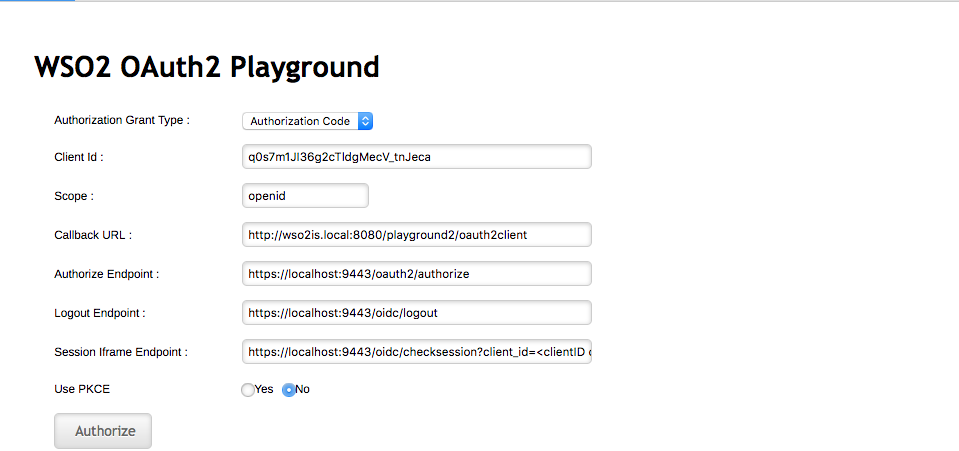Session Management with Playground¶
This topic documents instructions on how to test the OpenID Connect session management feature with the WSO2 Playground sample application as the Relying Party (RP) with WSO2 Identity Server as the OpenID Connect Provider (OP). See Configuring OpenID Connect Single Logout for more information.
Info
Relying Party (RP) and OpenID Provider (OP) definitions in this context is as follows,
Relying Parties (RPs) - OAuth 2.0 Clients using OpenID Connect
OpenID Providers (OPs) - OAuth 2.0 Authentication Servers implementing OpenID Connect
Prerequisites¶
-
In order to test the OpenID Connect session management feature, you need to have a relying party (RP) implementation. You can use either of the following options for this:
- The example pseudo-code for the RP iframe provided in the official specification.
- The WSO2 Identity Server
playgroundsample application. In this guide you will be using sampleplaygroundapplication to try out the scenario.
Before you begin
To deploy and configure the Playground sample, follow the steps here.
-
For this scenario we need two relying party applications. To do this, make a copy of the
playground2.warfile that was generated when you set up the sample webapp, and rename it as playground3.war in the same location.Navigate to the following URLs to check both were deployed properly. You will be able to see the following screen.
http://wso2is.local:8080/playground2/http://wso2is.local:8080/playground3/

Registering the relying party applications¶
-
In the previous section you have registered the
playground2webapp. If you complete that you can skip steps 2 to 5 below. -
Log into the management console.Add a new service provider named "playground2" and click Register.

-
Expand the Inbound Authentication Configuration section and then the OAuth/OpenID Connect Configuration and click Configure.
For more information, see Configuring OAuth2-OpenID Connect. -
Expand the Local & Outbound Authentication Configuration section and select Use tenant domain in local subject identifier to sign the ID token with the user's tenant domain.

Note
Alternatively, to sign the ID token with the service provider's tenant domain, open the
deployment.tomlfile found in the<IS_HOME>/repository/conffolder and set the following property to true.[oauth.oidc.id_token] sign_with_sp_key=true -
Enter
http://wso2is.local:8080/playground2/oauth2clientas the callback URL and click Add.

Note
At this point, you will see the client key and client secret.

Note these values as you will need them later in this process.
-
Repeat steps 1- 4 and register a service provider named as "playground3". This step is needed because you need to register the second replying party application "playground3`.
Testing session management with WSO2 Playground¶
-
Access the following URL :
http://wso2is.local:8080/playground2/and click on Import Photos. -
Enter the following values and click Authorize.
- Authorization Grant Type: Authorization Code (with this sample you can only test OIDC for the Authorization Code flow)
- Client Id: Enter the client ID (OAuth Client Key under Registering the relying Application, step 4) of the registered playground2 application
- Scope:
openid - Callback URL:
http://wso2is.local:8080/playground2/oauth2client - Authorize Endpoint:
https://localhost:9443/oauth2/authorize - Logout Endpoint:
https://localhost:9443/oidc/logout - Session Iframe Endpoint:
https://localhost:9443/oidc/checksession?client_id=<clientID of playground2 application>

-
Log in with the user credentials and click Approve Always at the consent page.
In order to enable single logout (SLO) you must use the Approve Always option. If this is not done, the passive request will not work, and without passive requests, the SLO protocol will not work. Do this to avoid errors during execution.

-
Once it is successfully authenticated, the OpenIDConnect Provider(OP) will redirect back to the client application with the authorization code and the session state. You can see this in the logs of the console, as seen below.
-
Enter the following values and click Get Access Token to receive the ID token and access token.
- Callback URL:
http://wso2is.local:8080/playground2/oauth2client - Access Token Endpoint:
https://localhost:9443/oauth2/token - Client Secret: Enter the client secret of playground2 application

- Callback URL:
-
You will receive the access token. You can also enter the UserInfo Endpoint as
https://localhost:9443/oauth2/userinfo?schema=openidto use the received access token to obtain user claims if needed.

-
Access the following URL on a separate window of the browser, and click on Import Photos:
http://wso2is.local:8080/playground3/ -
Repeat steps 2-6 to invoke the playground3 application. Make sure to change the Callback URL, Client Id and Client secret corresponding to playground3 application when you follow the steps.
Tip
Step 3 will not be prompted to you as there is already a valid session and WSO2 Identity Server will apply SSO for the second application.
-
Once you receive the authorization code for the playground3 app, open the browser console of the playground2 app. You will see that the RP iframe of playground2 has initiated a passive authentication request as the session state changed. Since the response has been received, the app will update it’s session state value and keep polling the OP iframe again.

-
Go back to the browser window of the playground3 app, and click Logout. Click Approve when prompted for consent.
- Go back to the browser window of the playground2 app. You will see
that the home page has loaded. If you check the console logs, you
will note that the the playground2 app’s RP iframe has initiated a
passive authentication request and has received an error since the
end user session has ended. This means the app has successfully
handled this as a single logout scenario.

How to keep the user session live in Identity Server
In WSO2 Identity Server, you can use an authorization endpoint to increase the session idle time.
To do this, add an iframe to the service provider application which
sends a prompt=none call to the OAuth2
authorization endpoint after each iteration of n minutes and refreshes
the user session at the server end. A sample iframe is shown below.
<iframe id="refresh_iframe" src="#" style="width:0;height:0;border:0; border:none;"></iframe><script>setInterval(function(){document.getElementById('refresh_iframe').src
="https://localhost:9443/oauth2/authorize prompt=none&scope=openid&response_type=code&redirect_uri=http%3A%2F%2Flocalhost%3A8080%2Fplayground2%2Fprompt-none callback.jsp&client_id=7x72byIYC40dlCuu6bovOTdK2MMa";},300000);</script>Tip
Redirect to a logout URL after RP-initiated logout
You can specify a logout URL so that the application redirects to a particular page after the RP sends the OpenID Connect logout request. For more information on how to configure the redirect logout, see OpenID Connect Logout URL Redirection.